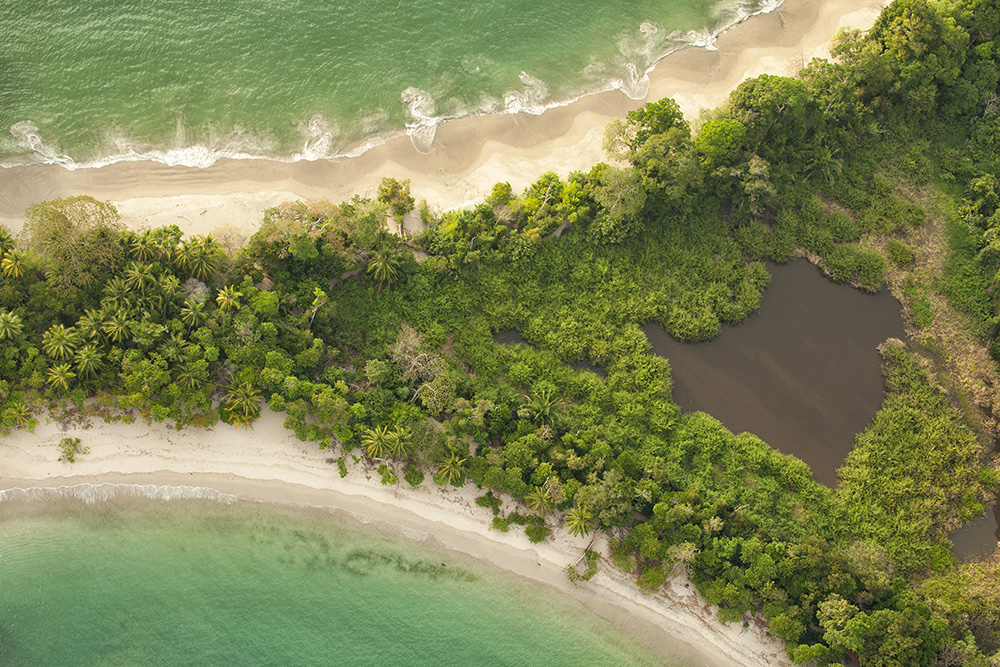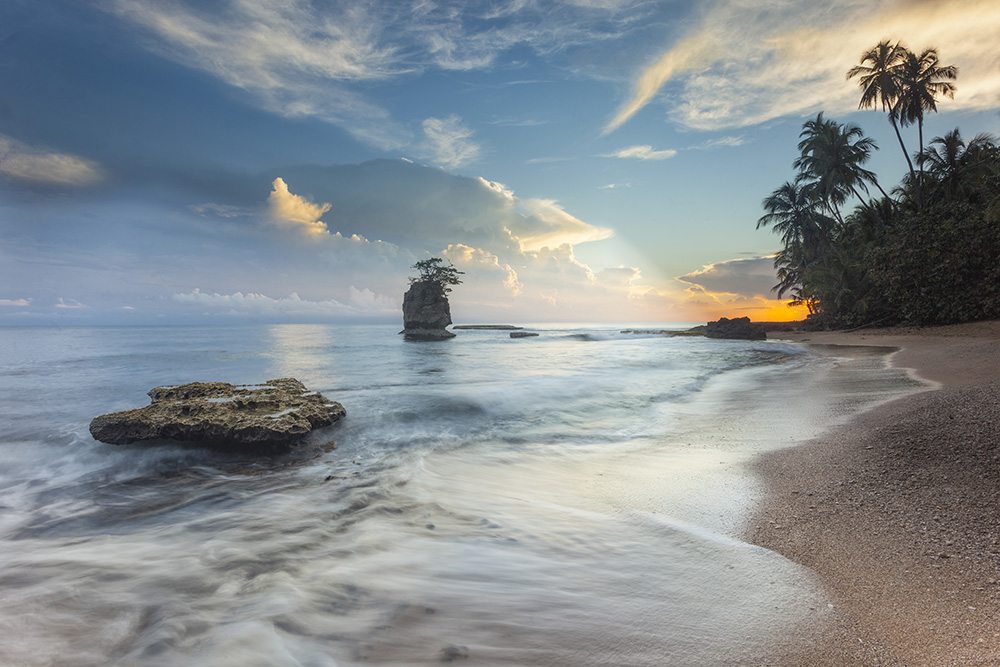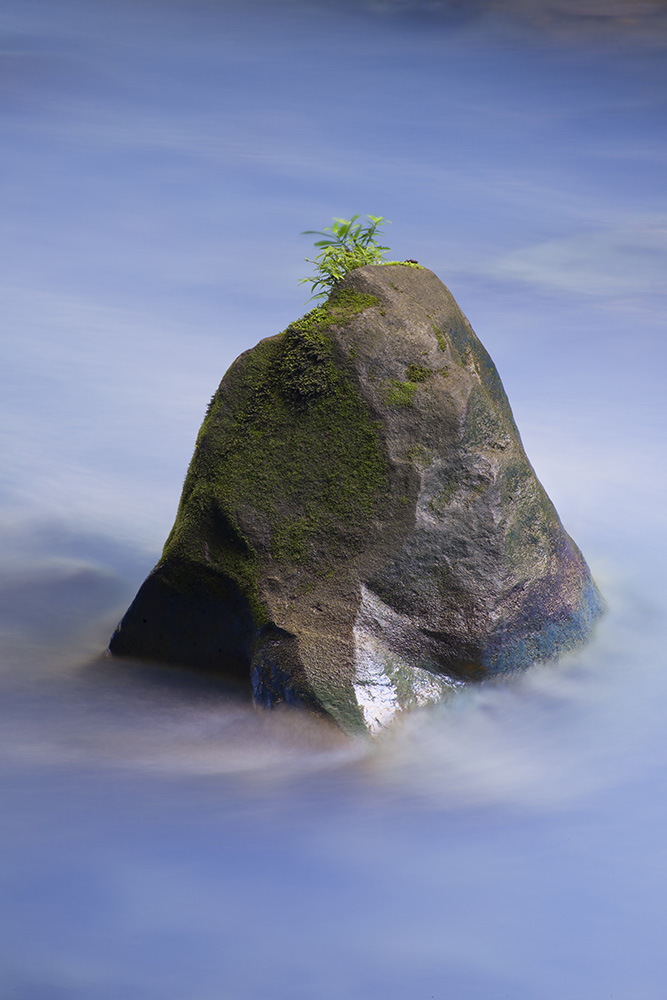Finding distinctive landscape images in dense rainforest can be tough, but there are some useful techniques you can use to increase your number of "keepers". National Geographic photographer Greg Basco explains.
Though I made my name photographing birds I’ve always been attracted to other types of nature photography. About three years ago I decided I was a pretty good bird and wildlife photographer and I also did a serviceable job with macro. I was, however, relatively deficient when it came to shooting landscapes.
I enjoy the challenge of learning new techniques so I decided to attempt to improve my landscape skills. I’ve had plenty of practice the past couple of years as my new coffee-table book of Costa Rican nature images required lots of wide perspectives to set the scene for the viewer. Though small, Costa Rica offers a myriad of landscape possibilities from high mountains to coastal scenes to dense lowland forests. Despite the apparently abundant and diverse opportunities, photographing landscapes in the tropics is especially difficult because there is very little good light and few open spaces. Nonetheless, with practice and patience one can make wonderful landscape images in the tropics.
In this article, I’ll share with you the lessons I’ve learned during my quest to become a better rainforest landscape photographer.

“I wanted to show this 110 metre high waterfall tucked away in the cloud forest rather than standing below it and shooting it head-on as most photographers do who visit this spot," says Basco. "I found a light gap with some broad-leafed Heliconias along the trail and used them to provide a frame for the main visual anchor, the waterfall." Canon EOS 5D, Canon 17-40 mm f/4 lens, 2.5s @ f/22, ISO 50, polariser, three-stop graduated ND filter, tripod, cable release. Standard tweaks in Lightroom.
01 COMPOSITION COUNTS
Making the point that composition is critical for landscape photography is both obvious and non-specific. Don’t all photographers need to have an eye for good composition? Certainly, but what makes this lesson especially pertinent for the rainforest photography is the difficulty in finding compositions.
The greatest challenge for rainforest landscape photographers is finding something to shoot! It sounds counterintuitive, but one of the very things that makes tropical forests so special – their luxuriant growth – makes it hard to find a sense of visual order amidst the chaos.
When focusing on landscape photography I often spend a whole day hiking through the rainforest and only shoot one or two scenes. The vast majority of your time is spent searching for scenes that have some semblance of order to them.
The best landscape photographers in non-tropical areas of the world work similarly of course, spending lots of time planning and finding the best views. Yet in my experience, landscape photographers working in open areas (such as many places in the temperate and higher latitude zones) often face two challenges which are the opposite of the big challenge facing a tropical landscape photographer.
First, in these more open areas the photographer is likely to have so many compositional options that narrowing things down becomes the important time-management issue. I was faced with this problem a few years ago while photographing in a hoodoo (or rock column) desert in New Mexico in the western United States. There were literally hundreds of options for good compositions. My stress came from trying to decide how to best spend my limited shooting time.
Second, since there might be plenty of great and fairly obvious compositional choices, it was likely that others had already done some great work in well-known landscape destinations. Doing something different from what everyone else has done becomes the big difficulty.
Neither of these problems is easy to deal with, but they are much different to the main problem facing the tropical landscape photographer, which is simply finding one good composition!
Compositions in a tropical forest tend to be subtle. Grand vistas are rare, and there is usually no fore, middle, and distant grounds. Looking for patterns is a great way to start to see, and studying compositional concepts such as the golden spiral and golden triangle can be a big help in bringing order to a chaotic forest.
"At the end of the day in a forest in Costa Rica’s Tenorio Volcano National Park, I found this giant liana," says Basco. "I set up by placing my lens just inches from my subject, underexposing the ambient light, and adding in a bit of off-camera flash on the liana to draw the viewer into the scene." Canon EOS 5D Mark II, Canon 17-40 mm f/4 lens, 13s @ f/22, ISO 400, flash, polariser, tripod, cable release. Standard tweaks in Lightroom.
02 THE BEST LIGHT
Good landscape photographers the world over plan their shoots to correspond with the best morning or afternoon light. What makes the tropical landscape photographer’s task different is that the ‘sweet’ light usually doesn’t exist and even if it did, in the forest it would be inconsequential. So, we can basically throw that strategy out the window unless we’re photographing a coastal scenic vista.
Why? It’s often cloudy in the tropics, but even when it’s clear, the good light lasts maybe 30 minutes at the beginning and end of each day because the sun is more perpendicular to the earth’s surface near the equator. And even then, I’m often in closed forests so the little good light we might encounter doesn’t help much. During the day, if it’s sunny, the light is too harsh for pleasing landscape photography. For this reason, I always look for cloudy days. The absolute best light you’ll find in tropical forests is where a bit of sun breaks through the mist, which can happen at any time of day.
This magical light is elusive, but when it happens, the resulting images can resemble paintings. The rainy season is usually the best time to find this kind of light. The normal rhythm of shooting early and late also doesn’t apply in tropical forests. Cloudy/drizzly weather usually ensures good soft light for shooting throughout the day. Indeed, sunny weather is generally the death knell for the tropical forest photographer shooting landscapes as it means harsh, dappled light and often is accompanied by breezy weather. The resulting broad dynamic range and subject movement are usually not what we want.

While dismantling gear from a multi-flash hummingbird session, the clouds parted during a rainstorm over the Juan Castro Blanco National Park. The light lasted just a few seconds so Basco shot handheld as there was no time to grab a tripod. A wider lens would have been great, but since he had a 70-300 mm lens mounted on a camera body, he used it to make a panoramic image. Canon EOS 5D Mk II, Canon 70-300mm f/4-5.6 lens, 1/160s @ f/5.6, ISO 500. Six vertical images stitched in Photoshop, standard tweaks in Lightroom.
03 RAINFOREST TRICKS
Despite the difficulty of finding good compositions and the best light in tropical forests, there are a few tips and tricks which can help. One of my favourites to overcome the general lack of depth in forest scenes is to get very close to a subject with a wide-angle lens. The exaggerated perspective helps to create distance between your foreground object and the surroundings.
Look for light gaps where a tree has fallen due to age, wind, or lightning. These light gaps are filled with quickly growing trees and large herbaceous plants with broad leaves and colourful flowers. Searching for light gaps in the forest is a good way to increase your chances of finding a workable composition. Because the tropical forest tends to be monotonous, looking for elements that break things up is always a good strategy. I find that water – be it a large waterfall, a tiny cascade, or a meandering stream – can add visual anchors and provide leading lines for tropical forest photos.
As landscape photographers, we tend to want to include the sky in our images. And a great sky certainly can make a photo. In tropical forests, however, the best light for most shots is overcast. That means the sky will be a featureless white or perhaps a light battleship gray – not what we want! Eliminating the sky from forest compositions is often the way to go.
A longer lens can help to create intimate landscapes, small swatches of larger scenes. Abstracting elements from a wider view is a good way to simplify complexity and produce visually interesting photos. Zoom lenses in the 70-200mm or 70-300mm range are perfect for these types of shots.
While great shots can be made from inside the forest, getting up and above the chaos can open up exciting landscape opportunities. Suspension walking bridges are becoming more popular in certain reserves, and they offer an easy way to get above the fray. The only drawback is bridge movement, which means that you have to wait for the crowds to pass and often have to shoot handheld. I’ve also been fortunate to be able to shoot from helicopters, gyrocopters, and ultra-light planes. Any of these options is a great, though expensive, way to produce different, eye-catching photos.
The budget option for getting an aerial perspective is to use local connections or just your feet! Research stations sometimes have observation towers not open to the public. Having the right contacts can get you access to some great views. But even when visiting a park as a regular tourist, putting in an extra hiking effort can offer rewards and take you away from the easier options tourists tend to look at first.
The arrangement of the vegetation in this scene adheres to the Golden Triangle rule, bringing a sense of order to the profusion of plant life. Canon EOS 20D, Canon 17-40 mm f/4 lens, 10s @ f/16, ISO 100, polariser, tripod, cable release. Standard tweaks in Lightroom.
04 GOOD GEAR
For landscape shooting I like to keep things simple and lightweight. One essential piece of gear is a circular polariser. Even if you like to do digital filtering in post processing, the polariser is one filter whose effect simply can’t be duplicated in the computer. I very rarely shoot a tropical landscape without a polarising filter.
Another key piece of gear is a lightweight tripod. I’ve come to love the Induro CGT114, which is super light and folds down to 17in (37.5cm), making it easy to strap on the side of my pack. With the short centre column, I can get low when necessary.
Here’s what I carry on any excursion to the forest, coast, or mountains to shoot tropical landscapes:
• Canon 5D III camera body
• Canon 16-35mm f/4 L IS zoom lens (the improved sharpness is great!)
• Canon 70-300mm f/4-5.6 L IS zoom lens
• Circular polarising filters for both lenses
• Formatt-Hitech filter holder system with various graduated and ND filters
• Lee Big Stopper 10-stop ND filter
• Cable release (one simple Canon model and one Phottix model with remote and interval function)
• Two Canon 430 EX flashes and Phottix Odin transmitter/receiver system
• Bubble levels
• Storm Jacket rain covers
• Induro CGT114 plus short centre column (this includes an Induro ballhead)
• Cloth ground cover for laying out gear on the forest floor
• Small umbrella (very portable!)
• Sunscreen
• Insect repellent (I’m loving Geraniol, which is made from Geranium extracts and doesn’t melt camera parts!)
• Gura Gear Kiboko backpack
"I waited two days for the overcast light I wanted for this large double-level waterfall tucked into the hills above Costa Rica’s Pacific Coast, says Basco. "When I got the right light, the sky contributed nothing to the image. Though I could have toned it down with a grad ND filter, I decided the sky would draw attention away from the waterfall so I cut my composition off just above the upper falls."
Canon EOS 5D Mk II, Canon 17-40 mm f/4 lens, 2s @ f/22, ISO 50, polariser, tripod, cable release, Standard tweaks in Lightroom.
05 STAY DRY
Rainforests are wet and humid and not always kind to camera gear. Nonetheless, if you take a few precautions you shouldn't have any problems.
First, pack your gear well in water-repellent camera bags and backpacks and sprinkle these liberally with silica gel packages. I’m intrigued by the new body and lens caps from BRNO, which integrates reusable silica gel packs inside the caps. (http://brnollc.com/page15/page15.html)
Second, when it starts to rain you need to cover up. A good rain cover for your camera and/or a small umbrella that clips onto your tripod can be very useful when shooting in drizzle or light rain. If the rain starts to get heavier garbage bags, disposable ponchos or dedicated camera covers can be really useful.
Third, make sure your gear is clean and dry at the end of each day's shooting. A compact hair dryer can help you dry off your bag and any accessories. If you don’t have a hair dryer, storing your gear in your camera bag with silica gel packets is a good strategy. If your room has airconditioning, this will help to dry out gear. Be aware, however, that keeping your gear exposed to airconditioning overnight will likely result in condensation when you head out into the forest the next day!
An ultralight plane got Basco where he needed to be in the late afternoon to show how Costa Rica’s famed Manuel Antonio National Park juts into the Pacific Ocean. “I’m always careful to look for graphic compositions when shooting aerials," he says. Canon EOS 5D Mk II, 70-300 mm f/4-5.6 lens, 1/640s @ f/5.6, ISO 640, polariser. Minor tweaks in Lightroom.
06 TECH TIPS
Mobile phones aren’t just for phone calls. I consider mine to be an essential piece of gear when I go out to shoot tropical landscapes. There are two apps that I love. The first is a depth-of-field calculator. The DOFMASTER app is great for iPhones, but is not available for Android. Since my phone runs Android, I use a free app called Photo Tools. It will give you hyperfocal distance but, more importantly for me, it offers detailed depth-of-field information so I can make intelligent choices about where to place my focus point to emphasise the elements most critical for a given image.
The second app is The Photographer’s Ephemeris (TPE), an inexpensive app which allows you to ‘geotag’ a location and then see detailed data on sunrise/sunset time and direction. Though I’m often in the forest, meaning this information might not be useful, when I shoot tropical coastal or mountain scenes, I’m calling up TPE on my phone every time! 
Basco scouted this location on Costa Rica’s Atlantic coast near Panama the day before around noon. “By using the phone app The Photographers’ Ephemeris (TPE) I determined I could shoot this beach at sunrise or sunset. The composition I wanted turned out to be a sunrise shot. With TPE I was able to get the exact time I needed to be there to catch the sun’s rays over the small rock island just off the coast." Canon EOS 5D Mk II, Canon 17-40 mm f/4 lens, 1s @ f/16, ISO 100, polariser, three-stop graduated ND filter, tripod, cable release. Standard tweaks in Lightroom.
Conclusion
While tropical landscape photography has a number of distinct challenges, the process is rewarding. You’ll improve your photographic skills and have some great adventures braving the elements. I hope this article has helped you to prepare for your next tropical landscape outing!
Greg Basco is a BBC/Veolia Wildlife Photographer of the Year and Nature’s Best Windland Smith Rice prize winner (most recently winning the Art in Nature category in the latter contest), and his photos have been published in many books, public exhibits, calendars, and other projects. He is also co-author of the popular e-book, The Guide to Tropical Nature Photography. Basco is the founder of Foto Verde Tours, Costa Rica’s first and only travel company specialising in photographic tourism. See Greg Basco’s work at www.deepgreenphotography.com
A medium telephoto zoom lens allowed Basco to isolate this metre-high rock in Costa Rica’s Rio Celeste. The sapphire blue water was the perfect setting. Canon EOS 5D Mk II, Canon 17-40mm f/4 lens, 1/125s @ f/9, ISO 800, polariser. Standard tweaks in Lightroom.











